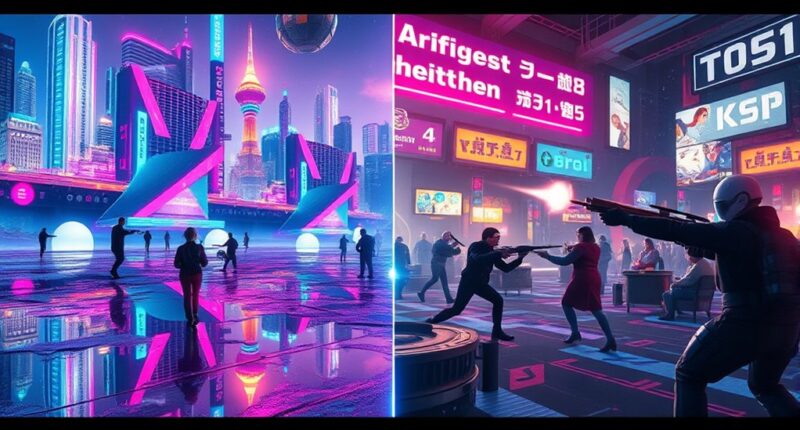Metaverse and GameFi both revolve around virtual economies and digital assets, but they serve different purposes. The metaverse creates a vast, social space for exploration, work, and identity, emphasizing immersive experiences and avatar customization. GameFi focuses on making gaming financially rewarding, with its economy centered on earning through gameplay. While they overlap in economies and avatar features, their core goals differ. Keep exploring to see how these worlds are shaping the future of digital interaction.
Key Takeaways
- Both involve virtual economies, digital assets, and avatar customization, but the metaverse emphasizes social and creative experiences.
- GameFi focuses on integrating financial incentives into gaming, while the metaverse aims for immersive, multifaceted digital environments.
- Avatar customization in the metaverse promotes self-expression; in GameFi, it often signifies gaming achievement or status.
- The metaverse encompasses social spaces, work, and creative outlets; GameFi primarily centers on gameplay and earning rewards.
- Both foster community engagement through digital assets, but their core objectives differ: social immersion versus financial incentivization.
The concepts of the metaverse and GameFi are often intertwined, but they serve different purposes in the digital landscape. You might think of the metaverse as a vast, interconnected virtual universe where users can explore, socialize, and build identities. GameFi, on the other hand, focuses on integrating financial elements into gaming, turning gameplay into a way to earn real value. While they overlap in areas like virtual economies and avatar customization, their core objectives differ considerably.
In the metaverse, virtual economies are fundamental. You can buy, sell, and trade digital assets, creating a complex ecosystem of currencies, NFTs, and virtual property. This economy isn’t just about gaming; it extends into social spaces, work environments, and creative outlets. You might own a virtual piece of land, design a unique avatar, or monetize your digital art. Avatar customization plays a vital role here—it’s how you express your identity and stand out in a digital crowd. You can personalize your avatar’s appearance, outfits, and accessories, making it a reflection of your personality or brand. These features foster a sense of presence and social connection, making the metaverse feel more immersive and personal. Additionally, portable camping gear can enhance virtual experiences by providing realistic interaction and engagement in digital environments.
GameFi, however, centers on the idea that gaming can be more than just entertainment. You earn tokens or digital assets by playing, which can be traded or used within the game or even exchanged for real money. The virtual economies in GameFi are designed to incentivize gameplay through financial rewards. While avatar customization exists in GameFi, it often serves a secondary purpose—enhancing gameplay or status rather than creating a fully personalized identity. In many GameFi platforms, your avatar’s appearance might be limited or tied to specific achievements, rather than open-ended customization seen in the metaverse.
Despite these differences, the overlap is evident. Both realms rely on virtual economies and digital assets to engage users. They also use avatar customization to foster user identity and community. However, in the metaverse, avatar customization emphasizes self-expression and social interaction, whereas in GameFi, it often centers around gameplay progression and status. Ultimately, the metaverse aims to create a living, breathing digital universe where various activities coexist, while GameFi transforms gaming into an economic ecosystem where earning and investing are integrated into gameplay. Understanding these distinctions helps you navigate and appreciate the unique opportunities each offers in the evolving digital landscape.
Frequently Asked Questions
How Do User Experiences Differ Between Metaverse and Gamefi Platforms?
You’ll find that user experiences differ mainly in their focus. In the metaverse, you enjoy immersive environments with avatar customization and extensive social interaction, making it feel more like a digital world you live in. On gamefi platforms, the experience centers around earning rewards through gameplay, with social features often secondary. While both involve avatars, the metaverse emphasizes community and exploration, whereas gamefi prioritizes gaming and earning opportunities.
What Are the Primary Technological Differences Between Metaverse and Gamefi?
You see the primary technological differences in how metaverse and gamefi platforms handle virtual economies and digital identities. The metaverse builds persistent worlds with interconnected virtual economies that support complex social interactions, while gamefi focuses on blockchain-based assets, decentralized ownership, and tokenized economies. Both utilize digital identities, but the metaverse emphasizes seamless integration across environments, whereas gamefi centers on secure, transparent ownership of digital assets and financial transactions.
How Do Monetization Models Vary in Metaverse Versus Gamefi Environments?
In metaverse environments, you mostly see monetization through virtual economies, where users buy, sell, and trade digital assets, and content licensing, which generates revenue from user-generated content. In contrast, gamefi models often rely on tokenomics, staking, and play-to-earn mechanics. You’ll find that virtual economies are central to both, but content licensing plays a bigger role in the metaverse’s broader scope and community-driven content creation.
What Are the Key Challenges Faced by Metaverse and Gamefi Developers?
You face key challenges in developing virtual economies and establishing digital identities, which require balancing security, scalability, and user trust. Ensuring seamless integration of immersive experiences while protecting user data is essential. You must also navigate evolving regulations and technological limitations. Overcoming these hurdles demands innovative solutions that foster engagement, safeguard privacy, and sustain growth, making your role indispensable in shaping the future of virtual worlds and blockchain-based platforms.
How Do Governance and Ownership Structures Compare in Both Spaces?
You’ll notice that ownership models and community governance differ in these spaces. In the metaverse, ownership often lies with centralized entities, though some platforms experiment with decentralization. In GameFi, ownership is typically token-based, giving players more control over assets through blockchain. Community governance is more prominent in GameFi, where token holders influence decisions, while the metaverse may rely more on platform operators for governance.
Conclusion
So, now you see how the metaverse and GameFi each carve out their own space, yet they often cross paths. While the metaverse offers a vast digital universe to explore, GameFi adds a financial twist to gaming, making every move potentially rewarding. Remember, don’t put all your eggs in one basket—understand their differences and overlaps before diving in. After all, knowing the lay of the land helps you stay ahead of the curve.








